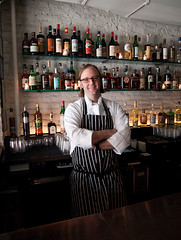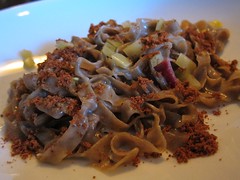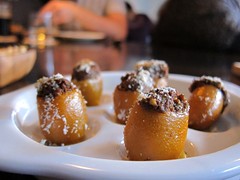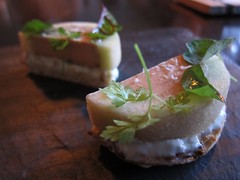Alder, chef Wylie Dufresne’s latest venture, has now been open 12 days. That’s a little less than two weeks of frenetic Internet buzz, of outlets like The Local trying to take pictures and ask questions, and long lines of foodies eager to have their conception of pub grub and cocktails deconstructed in delectable ways.
But despite the hype and all the stress that comes with it, Mr. Dufresne didn’t appear harried when we spoke to him last week. He looked exactly like every other time you’ve seen him: flawlessly trimmed angular sideburns, a chef’s coat he seems to sleep in, and a mien of Zen-like calm. He has a way of being friendly without smiling.
Sitting at the bar near the window, Second Avenue seemed a parade of familiar faces to him. The East Village, a few blocks from where he went to high school, has become a beacon for foodies, with marquee chefs setting up shop in droves. But Mr. Dufresne isn’t moving in; he’s been here all along. While his first restaurant WD-50 – a temple of avant-garde cuisine that celebrates its 10th anniversary today – introduced him to the world, Alder is re-introducing him to his neighbors. The Local spoke to him about his life — and now work — in the East Village.
Is it more difficult to open a restaurant now that you have such a reputation, and everybody’s watching?
Is it more difficult than it was to open WD-50? I don’t know. WD-50 was under quite a bit of scrutiny when it opened as well. It was a different kind of scrutiny. There wasn’t an Internet back then, and the ability for the anonymous blogger to weigh in instantly. I don’t know if I would say it’s more difficult, I’d just say it’s different. The game has changed, the rules have changed, the way it’s played has changed.
Does the instant feedback of bloggers change your approach?
A.
I think that depends on how you as an individual evaluate the blogosphere. I don’t think I’ll let anonymous people dictate what we do here. One has to be very careful with the blogs, because they can be wildly supportive or they can be corrosive. They can be detrimental to the psyche of the people who are working really hard on a daily basis to make this possible.
How long have you had this idea of putting a twist on pub food?
A long time. The idea of taking all we’ve learned [at WD-50] and making it more approachable – more physically approachable, more financially approachable – has been something that’s been going on in my head for a while.
You’ve placed an emphasis on Alder being affordable. Do you see it as part of a larger trend to bring more experimental cuisine to the average person?
I’m not so good at speaking to trends. I try to be aware of what’s going on, but I try not to let that dictate our approach, because I don’t think that would be honest to who we are. It’s about finding our own way of doing things. I think that people have always wanted a value; I don’t think that’s a new idea, giving somebody something that’s affordable. But again, the idea of a pub, a meeting place where people independent of their caste, can all gather, and that you can come in in a ball gown and I can come in in shorts and a T-shirt, and neither one of us would feel more or less awkward than the other, and we wouldn’t look at the other person and judge them in any value way – I think that an every person’s kind of place is always going to be a popular idea. I do think that fine dining is more difficult given the financial times we’re in. And I didn’t want to go up to Midtown, which is typically where you see more fine dining kind of establishments. I wanted to stay down here, in this type of neighborhood. I feel like this kind of neighborhood would both want and support this kind of approach.
I understand you grew up in the East Village.
Not far from here. I went to high school up on 16th Street, between Second and Third. My mother lives in Union Square. So this neighborhood is very personal to me. I know this neighborhood extremely well.
I imagine it’s changed a lot since then.
Up until very recently, I lived on 14th Street, between Second and Third. So I was watching it change — I have been around for it all. This was the area I grew up in, but I lived in other areas of New York, post-college. I lived in Times Square for a time. I went through its change. That was much more radical and severe. This is a slower change. But it’s still nice to see that there’s still a place for the small businessman, myself included. I think New York City is a hard place to be a small business owner in 2013. I’m glad to see there are still people making a go out of it. I think New York wouldn’t be the same without those people doing those things.
Did you always know you were going to open a restaurant in the East Village?
I wouldn’t say I always knew, but I was optimistic that if it was going to happen, it would be in this neighborhood. Or hopeful, because I like this neighborhood — it resonates with me as an individual. Now I feel like I’m part of Clinton Street, but when I started there in ’99, 2000, it didn’t mean anything to me as an individual. It wasn’t a place I had ever been, even. I didn’t know where Clinton Street was at first. Now I would like to think I’m part of the fabric of that street. But I wasn’t before. Whereas here, I was always part of the fabric, it’s part of my fabric. I feel comfortable here in this neighborhood. And at best, it takes me 10 minutes to walk home.
You’ve mentioned that dishes are a collaborative effort between the chefs. I’d love to know how a menu comes together. What does the trial and error process look like?
It can be very lengthy. You can’t just sit down and say, “Today we’re going to be creative. Today I’m going to do something wonderful.” You can’t force it. You can try and force it – and I think it’s good to try and force it – but you can’t will yourself to be creative all the time. But you can create an environment where it can happen from a lot of different directions, where different people can contribute to the process. I believe that no creative endeavor on earth is the work of one individual – it’s the work of a group. There isn’t one person that’s out there doing something wildly creative that doesn’t have influences from other places. I just don’t believe it. So I try to create an environment where people can share ideas. My executive chef [John Bignelli] has been with me for six years, so he and I have a dialogue that already exists. My sous chef [Ryan Henderson], who has been with me for several months, is beginning to understand that. We’ve got cooks that have only been here for a few weeks, and they’re not there yet; they’re more focused on getting themselves set up. But eventually the conversation will grow, and we’ll all be like, “Hey, what about this?” or “What about that?”
Do chefs share secrets? Or if you stumble across some new innovation, do you try and keep it for yourself?
There was a time when there was very little sharing. We’ve fortunately gotten over that, and people are more willing to say, “Hey look, this is how I do this.” More and more chefs are publishing books, revealing their secrets. There’s more of an exchange of ideas, a dialogue.
WD-50, Alder: How do you keep them separate? Do you lay out ground rules when you’re experimenting so each place will have its own distinct voice?
There are times when we’re working on a dish and we realize it’s better suited for one place over the other. We have a much smaller team [at Alder] – there’s four people back there; there’s 14 people at WD-50. Things have to be simpler, less time consuming. There are dishes that take days to make at WD-50 – we don’t have that luxury here, ’cause we don’t have the time or the space.
Where do see New York’s place in the world of cuisine?
I think it’s a great time to be in New York. There’s a lot going on. We’re sandwiched between Alex Stupak and Dave Chang, and over there there’s Michael White. And a couple of blocks over and down will soon be Andrew Carmellini’s new place; the Carbone just opened; Mission Chinese – I mean we can just keep going. And that’s just the top wrung of the ladder of chefs. It’s a great time to be in New York, a great time to eat here. Five or six years ago, New York was a little quiet. It’s a good moment right now.










